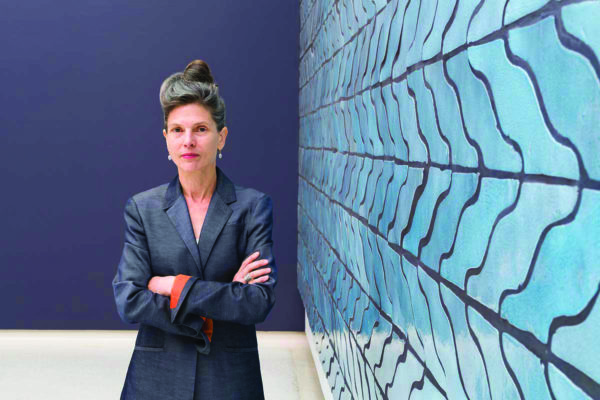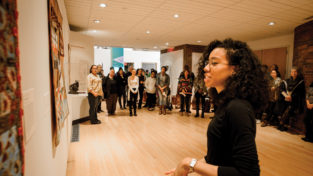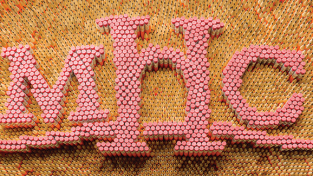The work of visual artist Joan Jonas ’58 is celebrated at the Mount Holyoke College Art Museum
A current exhibition at the Mount Holyoke College Art Museum creates space for the work of renowned artist Joan Jonas ’58

Joan Jonas ’58 has been creating art for more than 60 years. And in recent years, her work has earned her some of the highest accolades in the art world, including the 2018 Kyoto Prize in arts and philosophy. In 2015 she represented the United States at the 56th Venice Biennale, perhaps the world’s most important exhibition, with work from 89 nations.
Long recognized by the College as a remarkable alumna, in 2016 Jonas received an honorary doctor of fine arts degree from Mount Holyoke, addressing the graduating seniors from the stage of Gettell Amphitheater. And now, in a yearlong, focused exhibition, Jonas’ work is being put in front of audiences at her alma mater.
COMING HOME
“Promise of the Infinite: Joan Jonas and the Mirror” is the first-ever exhibition of Jonas’ work at Mount Holyoke, a celebration that also resulted in the museum acquiring one of her works into its permanent collection. The show opened in July 2018 and runs until June 16, 2019. The installation of four of Jonas’ works spans her prolific career and explores her ongoing use of the mirror, a theme Jonas has examined since the earliest days of her career.
Hannah Blunt, former associate curator at the Mount Holyoke College Art Museum and key organizer of the exhibition, was surprised to discover that the mirror had never before been the focus of a Jonas exhibition. She says that mirrors, like other elements of Jonas’ work, are “uncomfortable, risky, precarious.” While the mirror is a universal symbol, Blunt explained, there is tension in its use because what it reflects is a product of imaginations and assumptions.
Jonas’ work offers fragments and layers that can take time to put together or peel away, says Blunt. Because of these complexities it isn’t always easy, she says “to find an entry point.” Mirrors and the concept of image and reflection seemed like a good place to begin, offering a shared point of entry.
Jonas’ work as a “visual artist” (her preferred term) consistently blends intuition and preparation and is as relevant and evocative as ever. At a time when the selfie is a dominant form of visual (and, arguably, artistic) expression and communication, Jonas’ work plays with concepts of self and audience. Her use of mirrors and video (a kind of perpetual mirror) evokes narcissism, intended to make viewers uneasy. She uses the concept of the mirror to show that images are not facts but reflections of the individual ways that we see and interpret them.
The Mount Holyoke exhibition includes “My New Theater II: Big Mirror” (1998), in which viewers are asked to gaze down a long black square cone at a video. A small balsa wood chaise longue sits as an inviting prop. In the projection, Jonas is dancing, drawing, singing and reciting a poem. Some actions seem spontaneous, sometimes comically so, as if she is unaware of the camera. At times her movements seem unnatural and awkward. The video plays in a haunting loop and feels fragile and fleeting in the same way mirrors and their reflections are.
Other works in “Promise of the Infinite” include people wearing mirror-clad costumes, various looking- glasses and the camera as a figurative mirror. The piece “Mirror Pieces Installation II” (1969/2014) features a retro television set playing an early improvisational film made in Jonas’ Soho loft in which nude performers move around the space holding full-length mirrors.
Jonas has long been interested in the perception of women’s bodies and the tension between public and private.
“From the beginning as an artist, my dominant focus has been on the roles that women play — in folklore, fiction and in the culture at large — and how they are seen in history,” she told The Guardian last year.
Watch: A Conversation with Joan Jonas ’58 | Mount Holyoke College Art Museum
EARLY YEARS
As a Mount Holyoke student in the 1950s, Jonas studied sculpture and art history and read Jean Rhys, James Baldwin and Marguerite Duras, whose work had an enduring influence on her. She also came across Ezra Pound’s definition of an image as “that which presents an intellectual and emotional complex in an instant of time” — a concept that would resonate with her and that she has revisited consistently throughout her career. After college, Jonas attended the School of the Museum of Fine Arts in Boston and earned an M.F.A. in sculpture from Columbia University in 1965. She then studied choreography for two years while immersed in the 1960s New York art scene.
From the beginning of her career Jonas’ work was motivated by feminist ideas at a time when women were talking more about how they were depicted. In the now-iconic live performance “Mirror Check” (1970), Jonas inspected every inch of her naked body with a small hand mirror, in front of a live audience. The piece illustrates the way she used female imagery to consider issues of women’s rights.
Now several decades later, Jonas still pushes boundaries, and her exploratory, non-didactic, interdisciplinary approach means that, for viewers, spending time with her work can be a whole-brain endeavor. Jonas has also heard that, occasionally, viewers have been brought to tears by her creations.
“When I go to look at a work of art, I’m interested in the way it affects me, and how it changes my way of seeing things … I hope that my work can somehow give people a different way of seeing things, experiencing things,” Jonas says. “I think you can get something from just walking through, but the only thing I ask is that people give it time. If they don’t then that’s what they don’t see. I don’t try to control the audience,” she says.

Thinking Performance, Joan Jonas Mirror Piece Performance Reconfigured (1969/2010), performers from the Hunter college MFA program in studio at the Solomon Guggenheim Museum on Thursday, June 17, 2010, in New York, NY.
A CELEBRATED CAREER
Last year, the Tate Modern held a career retrospective of Jonas’ work, a massive exhibition that spanned multiple levels of the museum and brought viewers through work representing decades of creativity and exploration. The first objects visitors encountered were meant to evoke a feeling of tension and suspense — papier-mâché and wire-mesh masks of various humans and animals, wooden carvings and a variety of stones. These and similar items normally surround and inspire the artist in her Soho loft, where she has lived and worked for nearly 60 years.
“In the past I’ve begun with one idea, or an element, or a shape — like a cone,” she says. She then asks as many questions as she can: “What shape is that? What can you do with it? How can you use it? What does it refer to? What is its history, if you look at other sources in which that form appears?”
But Jonas is not limited to her own questions and discovery. Other times the origin of a piece may be a myth, fairytale, novel or poem. She deconstructs stories into key elements and rebuilds them into something entirely unique and contemporary. Such is the case with “The Juniper Tree” (1976/1994), based on the eponymous Brothers Grimm tale and included in the Tate installation. The work was originally a performance piece and in the exhibition at the Tate included props arranged in the space to suggest a visual poem. Two-dozen silk canvases, painted red and white with simple, grotesque portraits, were displayed on the walls. A lighted mask of a woman lay atop a bundle of sticks underneath a wooden structure, representing the canopy of a tree. A colorful kimono hung from a ladder nearby. The elements of the piece gave the Tate museum-goer the experience of being immersed in the story of an evil stepmother with themes of jealousy, murder and deceit.
And while murder and deceit aren’t likely to immediately call to mind the concept of beauty, much of Jonas’ work is visually exquisite.
“My work has always included an idea of beauty … but, when I start to make an image, I don’t think, ‘I want to make a beautiful image.’ There’s no formula for that. I think if I tried to make beautiful things, I would fail. I don’t want to be sentimental or beautiful in the sense that Renoir, for instance, is beautiful,” she says. Instead she says she has been influenced by artists Piero della Francesca and Alberto Giacometti, whose forms aren’t conventionally beautiful but may express beauty in harmony or balance.
Jonas has received the highest praise and recognition for her work. In addition to the Kyoto Prize and the Venice Biennale, her artwork has been included six times in Germany’s high-profile dOCUMENTA, an international exhibition of contemporary art that takes place every five years. Her multi-media installation piece, “They Come to Us Without a Word,” evoked a world in ecological peril, about which The Guardian reported, “In a show with too little regard for form, her profound and affecting new work proves that politics and beauty are not at odds.”
The New York Times celebrated the same piece as “one of the best solo shows to represent the United States at the Biennale in over a decade — an effortless combination of maturity and freshness.” The New York Times Style Magazine commented, “Now, as [Jonas] reaches the height of her creative powers, the art world is finally catching up with her.”

Ingrid Schaffner ’83 (Carnegie International)
PEER RECOGNITION
Ingrid Schaffner ’83, a prominent curator, art critic, writer and educator, agrees. “Joan’s pavilion for Venice was one of the most beautiful, lasting, profound works of art I’ve ever experienced,” she says.
Schaffner hit her own careerhigh recently with an exhibition to which Jonas contributed — the 57th Carnegie International, one of the world’s leading surveys of contemporary art. The show opened in October with the work of more than 30 artists selected by Schaffner. For 15 years she was chief curator at the Institute of Contemporary Art at the University of Pennsylvania, but in 2015 Schaffner moved to Pittsburgh to devote herself to the Carnegie show. It was three years in the making, and Schaffner’s research took her all over the world, including Africa, Eastern Europe, the Caribbean and Southeast Asia.
At a moment when concepts such as nationalism and borders are prominent, the exhibition explores what “international” means. In the show, Schaffner focused on the concept of “museum joy,” which, she explained, has a two-pronged meaning — to find delight in looking at art with others while also appreciating the role of art in society. “Museum joy is not a like thing but a critical thing; it’s work we have to do to build culture at this moment when we’re in a culture war. Museums have to do their work and energize.” For artists and visitors alike, she says, “That work is about how we are drawing connections across time and space and how we have to create new narratives and histories.”
Hanging overhead in one gallery, alive and fluttering, Schaffner included an installation that is a collaboration between Jonas and Art Labor, a trio of Vietnamese artists. Traditional Vietnamese kites painted by Jonas to evoke a jungle are displayed from the ceiling. They are part of a larger installation that resembles a hammock café of the kind that make popular pit-stops in Vietnam and that also bring to the forefront the experience of traveling soldiers who carried hammocks with them during the Vietnam War. The collaboration, which blends the work of different generations of artists, is emblematic of Jonas’ energy and generosity, says Schaffner.
“We’ve been learning from her for decades,” Schaffner says. “She’s been present for her work, and teaching has been an important part of that.” (Jonas is also professor emerita at the Massachusetts Institute of Technology, where she taught from 1998 to 2014.) The Carnegie International is open through March 25, 2019.
DRIVING FORWARD
At Jonas’ core, driving all of her innovation, is a deeply inquisitive mind. “I’m very interested in life and still curious about many things,” she says.
Her work, says Schaffner, defies genre. “Joan touches down in many places,” she says. She often incorporates into new installations elements of earlier work — both objects and ideas that recur and knit together several decades of her creations. And it is in this continuity of work that she has found her voice as an artist over time.
“In the beginning I certainly didn’t do it consciously. I wasn’t thinking about it in that way exactly. But what I did think about consciously was that I wanted to develop my own language,”
Jonas says. “I translate these ideas and images into my own visual language, which is something I’ve built up over the years.” Jonas is energized in particular by travel and new experiences, and then is propelled forward by some unseen but inevitable force.
“I’ve always been motivated by an unconscious drive, and once I began I couldn’t really step back,” she says. “I think as you have more experience and get older, as I am, you become more confident in your own language and you trust your judgment in a different way. But you still have to stay on a kind of edge. I believe that questioning, that self-doubt, is very important. An artist should never rest, be satisfied; there is a kind of drive in that sense.”
Heather Baukney Hansen ’94 is an independent journalist. She writes frequently for the Alumnae Quarterly.
This article appeared as “Promise of the Infinite” in the winter 2019 issue of the Alumnae Quarterly.
February 22, 2019











Leave a Reply